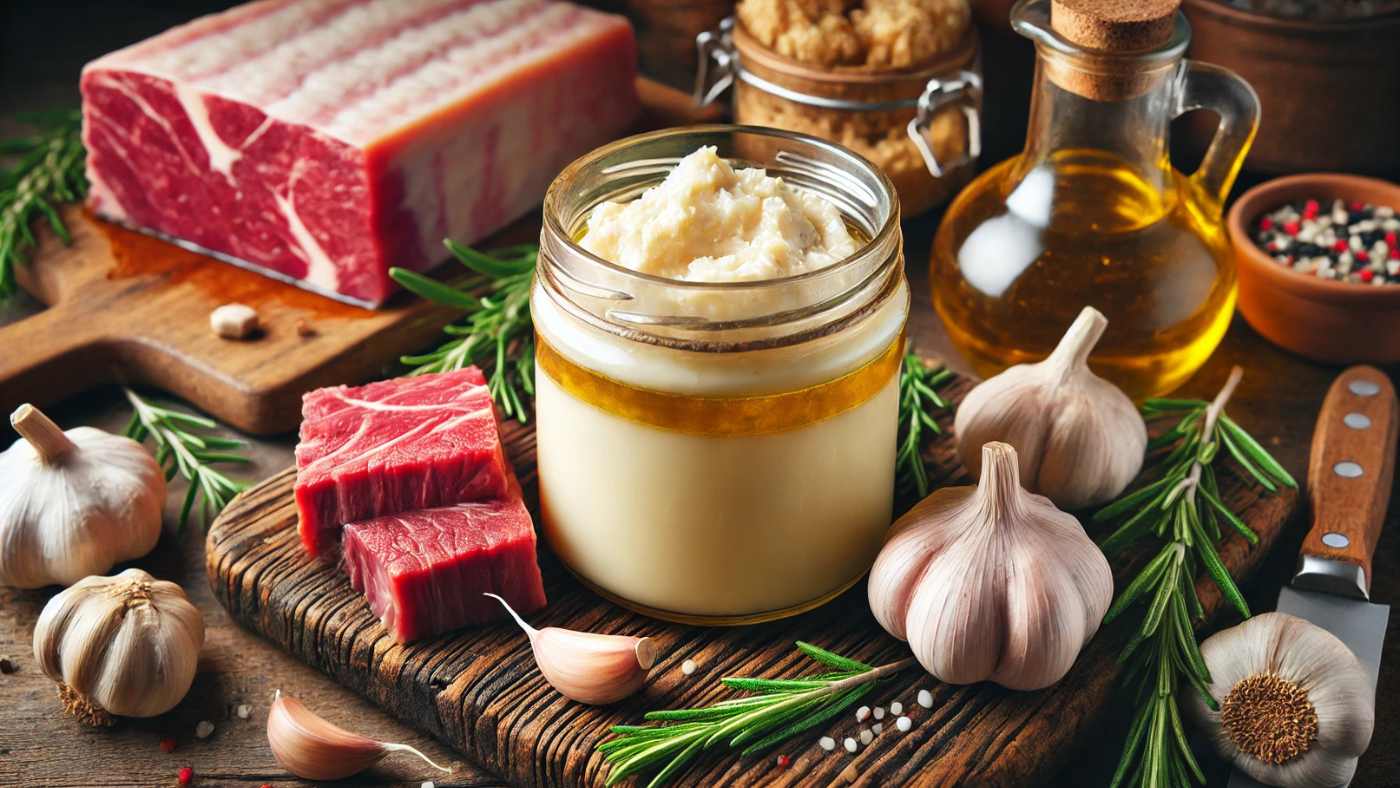How to Use Beef Tallow: Delicious Recipes You Can Try Today

Beef tallow has been used for centuries, making a big comeback in kitchens today.
If you're looking for an ingredient that adds rich flavor to your dishes and offers health benefits, beef tallow might be the perfect choice.
In this blog, you'll learn everything you need to know about beef tallow, including its definition, health benefits, and uses in cooking and even skincare.
Let's dive into some delicious beef tallow recipes you can quickly try at home.
What is Beef Tallow?
Beef tallow is simply rendered fat from cattle.
To obtain pure, shelf-stable beef fat, rendering entails gradually heating the fat until it melts and then filtering away any contaminants.
Historically, beef tallow was a common cooking fat used in everything from frying to baking.
Over time, however, it was replaced by processed vegetable oils.
People's interest in using it for cooking, skincare, and other purposes has recently increased due to their rediscovery of its adaptability and health advantages.
When it comes from grass-fed cattle, beef tallow is full of vitamins and beneficial fats that promote health.
Choosing high-quality tallows from small, responsible producers that align with sustainable practices is essential.
Why Cook with Beef Tallow? (Health Benefits and Uses)
There are several advantages to cooking with beef fat for the environment and your health.
First, let's look at its nutritional profile:
- It’s high in healthy saturated fats and more stable at high heat than polyunsaturated fats in vegetable oils.
- Beef tallow, especially from grass-fed cattle, is rich in fat-soluble vitamins like vitamins A, D, E, and K (1).
Regarding cooking, beef fat is perfect for frying, roasting, and sautéing because of its durability at high temperatures (2).
Unlike vegetable oils that oxidize at high heat, beef tallow remains stable, preserving the nutrients in your food and reducing the risk of creating harmful free radicals.
Here’s how beef tallow compares to other fats like butter and vegetable oil:
- Butter: Tallow is more suitable for high-heat cooking due to its higher smoke point, even though both butter and tallow are high in saturated fats.
- Vegetable oils are often highly processed and contain harmful trans fats. In contrast, tallow is a natural, whole fat (3).
Regarding environmental sustainability, using beef fat is an excellent way to minimize waste.
Beef fat that would otherwise be discarded is turned into a functional, nutrient-dense product, supporting zero-waste and sustainable food practices.
Purchasing beef tallow from local farmers who prioritize hormone-free, grass-fed livestock is good for the environment and for your health (4).

Easy and Delicious Beef Tallow Recipes for Everyday Cooking
Now that you know why beef tallow is a great cooking fat, it’s time to try some easy recipes that you can enjoy at home.
Here are four easy yet delicious ways to prepare beef tallow.
Recipe 1: Crispy Beef Tallow-Roasted Vegetables
Beef tallow will elevate your favorite crispy roasted veggies to a new level.
Ingredients:
- Assorted vegetables (carrots, potatoes, brussels sprouts, etc.)
- Two tablespoons of beef fat
- Salt and pepper to taste
- Fresh herbs (optional)
Instructions:
- Preheat your oven to 400°F.
- Toss your chopped vegetables in melted beef fat, ensuring they are evenly coated.
- Add salt, pepper, and your preferred herbs for seasoning.
- Add salt, pepper, and your preferred herbs for seasoning.
The beef fat adds a deep, savory flavor that’s hard to beat, and it helps the vegetables crisp up beautifully.
Recipe 2: Beef Tallow Fries (The Perfect Crunch)
Beef tallow fries are famous for their incredible crispness and flavor.
Ingredients:
- 3-4 large potatoes
- 1 cup beef tallow
- Sea salt
Instructions:
- Peel and slice the potatoes into thin fries.
- Heat the beef fat in a deep skillet to 350°F.
- Fry the potatoes in batches for three to five minutes until golden and crispy.
- Drain on a paper towel and sprinkle with sea salt.
Beef tallow fries are a healthier and tastier alternative to those made with processed oils.
Recipe 3: Beef Tallow Pie Crust
I am looking for a way to add richness to your savory pies. Try this flaky beef tallow pie crust.
Ingredients:
- 2 cups flour
- ½ cup cold beef tallow
- ½ teaspoon salt
- 4-6 tablespoons cold water
Instructions:
- Mix the flour and salt in a bowl.
- Cut in the cold beef fat until the mixture resembles coarse crumbs.
- One tablespoon of cold water should be added gradually until the dough forms.
- Roll out the dough and use it in your favorite pie recipe.
The beef tallow pie crust is ideal for savory dishes like pot pies or quiches.
Recipe 4: Beef Tallow Sautéed Greens
For a quick and nutritious side dish, use beef tallow to sauté leafy greens.
Ingredients:
- One bunch of leafy greens (spinach, kale, or collard greens)
- Two cloves garlic, minced
- One tablespoon beef tallow
- Salt to taste
Instructions:
- Heat the beef fat in a skillet over medium heat.
- Add minced garlic and cook for 30 seconds.
- Toss in the greens and sauté until wilted, about 3-4 minutes.
- Season with salt and serve.
Beef tallow brings out the natural flavors of the greens and gives them a lovely, rich finish.
Can You Use Beef Tallow for Skincare? (Dual Benefits)
Not only is beef tallow excellent in the kitchen, but it’s also great for your skin.
Because it’s rich in fatty acids like stearic and oleic acid, beef tallow closely mimics the natural oils in your skin (5).
Here are the skincare benefits of beef tallow:
- It leaves your skin feeling moisturized and silky after profoundly moisturizing it.
- It’s non-comedogenic, meaning it won’t clog your pores.
- The vitamins in beef fat, particularly vitamins A and E, support healthy skin and help reduce inflammation.
You can easily make a beef tallow balm at home by melting fat and mixing it with a few drops of essential oils.
Once it has cooled, this balm can be used to moisturize chapped lips, dry skin, and even the face.
How to Store Beef Tallow Properly to Prevent Spoilage
To keep your beef tallow fresh, you’ll need to store it correctly.
Here are some storage tips:
- Store your fat in an airtight container.
- Keep it in a cool, dark place like a pantry.
- You can freeze it or refrigerate it for extended storage.
Properly stored beef tallow can last for up to a year, making it a long-lasting and economical fat to have on hand.
Cook smarter, not harder—experience the high-heat stability of Wild Food Beef Tallow in your kitchen.
Final Thoughts
Beef fat is one of the most versatile ingredients you can use in your kitchen.
Not only is it excellent for high-heat cooking, but it is also a natural, healthy fat that adds depth and flavor to dishes.
Additionally, its use in skincare makes it a truly multi-purpose product.
Beef tallow supports sustainable, zero-waste practices, and by choosing responsibly sourced fat, you’re also supporting small producers and better environmental practices.
If you want to enhance your cooking while making a healthier, eco-friendly choice, beef tallow is a must-try.
Start with one of these delicious recipes and see how beef tallow can transform your cooking.
FAQs
What can you do with beef tallow?
Beef tallow can be used for cooking, such as frying, roasting, and sautéing. It’s also great for skin care and can be used in balms and moisturizers.
Is beef tallow healthier than butter?
Indeed, beef tallow is healthier to cook with since it is more stable at high temperatures. Compared to butter, it has higher levels of vitamins and good fats.
How do I make beef fat at home?
You can make beef tallow by slowly rendering beef fat over low heat until it melts, then straining it to remove impurities.
Can beef tallow go bad?
Although beef tallow can spoil, it can be kept for up to a year in an airtight container in a cool, dark place.
Is beef tallow suitable for frying?
Yes, beef tallow’s high smoke point makes it ideal for frying, giving your food a crispy texture without burning the fat.
Related Studies
1. Title: Nutritional Profile and Health Effects of Beef Tallow
This study evaluates the nutritional value of beef tallow, highlighting its rich content of vitamins A, D, E, and K, and discusses the potential health benefits associated with its consumption.
Link: https://healthnews.com/nutrition/healthy-eating/is-beef-tallow-healthy/
2. Title: Oxidative Stability of Cooking Fats
This study investigates the oxidative stability of various cooking fats, including beef tallow and vegetable oils, revealing that beef tallow is more stable at high temperatures and less prone to harmful oxidation.
Link: https://mcpress.mayoclinic.org/nutrition-fitness/what-is-beef-tallow-is-it-good-for-me/
3. Title: The Role of Saturated Fats in Heart Health
This research compares the health effects of saturated fats in beef tallow with trans fats found in vegetable oils, suggesting that saturated fats may not be as harmful as previously thought.
Link: https://wellnesswithkaelyn.com/blog/beeftallow
4. Title: Nutritional Benefits of Grass-Fed Beef
This study demonstrates that grass-fed beef has higher concentrations of omega-3 fatty acids and fat-soluble vitamins compared to grain-fed beef, supporting its nutritional superiority.
Link: https://draxe.com/nutrition/tallow/
5. Title: Benefits of Stearic and Oleic Acids in Skincare
This research explores the use of stearic and oleic acids in skincare formulations derived from animal fats like beef tallow, showing their positive effects on skin hydration and barrier repair.
Link: https://healthnews.com/nutrition/healthy-eating/is-beef-tallow-healthy/

